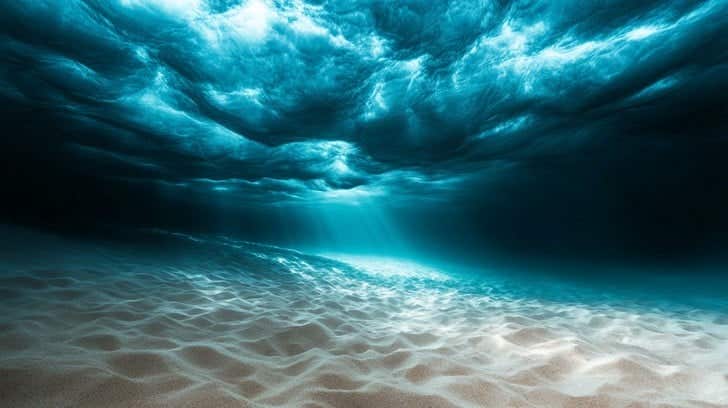Only 0.001% of the ocean floor has been explored – posing significant global challenges
New research highlights how less than 0.001% of the deep ocean has been visually explored, stressing the need for increased global efforts.

A recent study reveals a startling truth: humanity has visually observed less than 0.001% of the deep ocean. (CREDIT: StockCake Images)
Despite covering most of Earth's surface and providing crucial resources, the deep ocean remains largely unseen and misunderstood.
A recent study published in Science Advances reveals that humanity has visually explored less than 0.001% of the deep seafloor, an area roughly equivalent to Rhode Island or about one-tenth of Belgium. This limited exploration poses a significant challenge in accurately understanding and conserving the largest ecosystem on our planet.
A Vast and Vital Frontier
Deep oceans, defined as depths beyond 200 meters, encompass about two-thirds of Earth's surface. Despite their vastness, these regions are the least explored parts of our planet. The deep ocean hosts diverse life forms and plays essential roles in climate regulation, oxygen production, and supplying valuable resources such as food and medicines.
Phytoplankton living in ocean surface waters produce about 80% of Earth's oxygen, supported by nutrients brought up from deep ocean currents. Marine organisms also assist in absorbing significant amounts of atmospheric carbon dioxide, contributing to climate stabilization. This process alone has an estimated annual value of $159 billion.
The ocean supports human life directly, providing 200 million tons of seafood each year and employing about 60 million people globally. Additionally, marine organisms like sponges and bacteria have led to breakthroughs in treatments for diseases including HIV, breast cancer, and COVID-19. Over the past five decades, scientists have found thousands of new marine compounds with potential medical applications.
Limited Exploration Creates Significant Gaps
Despite its importance, humans have visually documented very little of the deep ocean. Researchers from Ocean Discovery League analyzed data from around 44,000 deep-sea dives conducted since 1958. Their findings highlight stark limitations in visual exploration.
Related Stories
The majority of recorded dives occurred near just three countries: the United States, Japan, and New Zealand. Furthermore, 97% of all visual explorations were done by only five nations: the U.S., Japan, New Zealand, France, and Germany.
This highly concentrated exploration leads to biased and insufficient data, making it difficult for scientists to accurately understand the entire deep-sea environment. Dr. Katy Croff Bell, President of Ocean Discovery League and lead author of the study, emphasizes, "We need a much better understanding of the deep ocean's ecosystems and processes to make informed decisions about resource management and conservation."
Threats from Human Activity
Human activity has been negatively impacting deep ocean environments for centuries, primarily through pollution, resource exploitation, and climate change. Researchers predict these harmful impacts will nearly double in coming years due to intensified exploitation and warming.
The oceans have already absorbed approximately 90% of excess heat and 30% of carbon dioxide from human activities. This has led to warmer temperatures, reduced oxygen levels, and increased ocean acidity. Such changes make deep ocean habitats inhospitable, disrupting marine life across various depths and affecting global biodiversity and productivity.
Emerging activities such as deep-sea mining and marine carbon dioxide removal pose additional risks. Studies indicate these activities could cause irreversible harm without careful scientific oversight. Dr. Bell stresses, “As we face accelerated threats—from climate change to potential mining—limited exploration becomes a critical problem for both science and policy.”
Uneven Exploration Focus
The study also underscores uneven exploration across different underwater habitats. Geological features like ocean canyons and ridges have received significant attention, while expansive areas such as abyssal plains and seamounts remain largely unseen. This uneven focus further distorts understanding, potentially missing critical biological discoveries or geological processes vital to Earth's overall health.
Past visual explorations often provided limited data, with almost 30% occurring before 1980 and resulting in low-quality, black-and-white images. This incomplete historical record further complicates current assessments of the deep seafloor.
Advancing Global Exploration
Scientists argue that expanding deep ocean exploration must be a global priority. This includes developing accessible, affordable exploration tools to involve more countries, especially low- and middle-income nations.
Dr. Ian Miller, Chief Science and Innovation Officer at the National Geographic Society, notes the importance of inclusive research: “Deep-sea exploration led by scientists and local communities is crucial to better understanding the planet’s largest ecosystem.”
Advancements in technology, such as affordable deep-sea imaging tools, offer promising pathways to democratize ocean research. Making exploration accessible globally can create a more representative picture of deep-sea ecosystems and foster international cooperation in conservation efforts.
A Call to Action
The researchers emphasize an urgent need for collaborative, comprehensive approaches to better explore and protect the deep ocean. Their findings stress that current understanding, based on such minimal and biased data, would be like studying Earth's terrestrial ecosystems based solely on observations from an area the size of Houston, Texas.
This significant gap in knowledge underlines the urgency for enhanced exploration. Dr. Bell’s initiative, supported by organizations like National Geographic and the Rolex Perpetual Planet Expeditions, aims to empower coastal communities worldwide with tools and knowledge to lead research and conservation efforts.
“There is so much of our ocean that remains a mystery,” Dr. Miller explains. “If we have a better understanding of our ocean, we are better able to conserve and protect it.”
Addressing these challenges now can shape how effectively humanity manages and conserves ocean resources in the future, ensuring the sustainable health of our planet's most vital ecosystem.
Note: The article above provided above by The Brighter Side of News.
Like these kind of feel good stories? Get The Brighter Side of News' newsletter.



